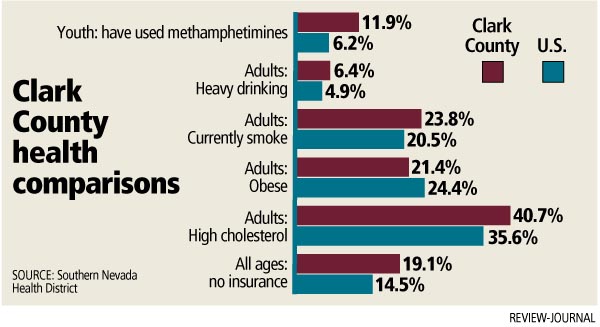Unhealthy ways: Locals indulge

More people smoke, binge drink and use hard drugs in Southern Nevada than elsewhere in America.
But we’re not as fat.
The first report on the overall health of Clark County residents by the Southern Nevada Health District was far from a clean bill of health. Southern Nevadans don’t live as long as the average American, and they’re more likely to suffer from chronic diseases such as diabetes.
But the health district’s chief health officer, Dr. Lawrence Sands, said that despite the variations from national norms, people in Clark County are largely representative of Americans overall.
One bright spot: The obesity rate, at 21.4 percent in 2005, remains lower than the national average, which was 24.4 percent that year, according to the Centers for Disease Control and Prevention.
But the local rate is up more than 3 percentage points since 2000 and continues to rise.
“If we keep going as we are, we’ll probably come up to that (national) rate or pass it,” Sands said.
The rise in obesity led to increases in other categories, he said.
The share of county residents with diabetes and high cholesterol are both above the national average, though the rate of diabetes is down since 2000. And among people 65 and older, hypertension was higher than the national average.
Another bright spot was the county’s high school students, who were less likely to smoke, drink alcohol and use marijuana than their peers nationally, according to 2005 figures.
The life expectancy for Southern Nevadans was lower than the national average, 76.7 years compared with 77.9, in 2004, according to the Centers for Disease Control and Prevention.
The health district report did not look at the reasons behind the trends, Sands said. The purpose of the study, which accumulated data from county, state and federal agencies, was to get information out to health care providers and other organizations.
Maintaining a healthy weight, eating right and exercising remain the best ways to stay healthy and ward off diseases such as diabetes, Sands said. But fewer than one in four people in Clark County eat the recommended five fruit and vegetable servings, according to the report.
Meanwhile, locals engaged in unhealthy activities at greater rates than the rest of the nation in 2005, according to the report:
• 23.8 percent of adults smoke.
• 16.7 percent binge drink.
• 6.4 percent drink heavily, which was defined as drinking more than two drinks per day for men or more than one drink per day for women.
Among high school students in Clark County in 2005, the following was found:
• 11.9 percent used methamphetamine, nearly double the national average.
• 1 in 10 had attempted suicide in the past year.
• More than 1 in 10 had driven while drinking during the past month.
There were some things Southern Nevadans fared better with, and there were signs that health care might be improving.
Local high school students, despite delving more into serious drugs, were less likely in 2005 to engage in other forms of risky behavior.
For example, 17 percent carried weapons, compared with 19 percent nationally.
And 24 percent of local high school students engaged in episodic heavy drinking, defined as having five or more alcoholic drinks in a row on at least one day during the past month. That was slightly lower than the 26 percent national average.
When Clark County residents of all ages were asked about their health, fewer reported their condition as “fair” or “poor” in 2005 than in 2000.
And mental health improved, with significantly fewer people reporting frequent mental distress, defined as experiencing stress, depression and problems with emotions 14 out of the past 30 days. Between 2000 and 2005, the rate dropped from 10.5 percent to 8.1 percent.
None of the data in the report was surprising or unexpected, Sands said, and residents in the county have been experiencing the same trends as the rest of the country.
“I think it kind of tells us that (we’re) still similar to Americans in general,” he said.
Among the more troubling statistics for officials is the increasing lack of health insurance for Southern Nevadans.
Nineteen percent of Southern Nevadans have no access to health insurance compared with the national average of 14.5 percent.
Cancer rates were higher in Southern Nevada, with lung cancer and breast cancer much higher than the national average.
The report, released in two segments this year, was the first of its kind for Clark County, Sands said. The health district plans to update the report next year and periodically in the future.












